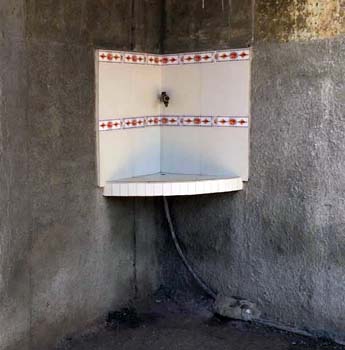There are four primary technologies commonly used to purify drinking water. These are:
-
Chlorine
Many municipal water systems in the more developed countries add chlorine to the water to kill bacteria
and other pathogens.
The amount of chlorine, and its "contact time" with the water
(the amount of time the chlorine is in solution with the water before the water is used)
must be carefully controlled to insure adequate elimination of pathogens.
This approach is probably best suited for municipal water supplies,
although fairly strong solutions of chlorine are frequently used to "shock"
the initial installation of some of the other technologies listed below.
-
Ozone
Ozone is formed when a third oxygen molecule is added to the normally diatomic oxygen molecule,
resulting in a three-atom molecule.
Ultraviolet light in the upper atmosphere, and electrical discharges, are two common ways ozone
can be formed.
Ozone is a strong oxidizer. It is unstable, and readily gives up one of its three oxygen atoms
providing a powerful oxidizing agent which is toxic to most waterborne organisms.
It can be infused into water,
where it can facilitate the normal process of organic breakdown. As with chlorine,
care needs to be taken to provide sufficient ozone concentrations and "contact time" with the water.
One organization using this approach is
Living Waters for the World.
-
Micro-Filtering
Most bacteria are fairly large and can be removed from water by adequate filtration.
One expert we consulted remarked: "Cholera is large enough to be caught in a butterfly net."
Filtration also removes the sediment from the water. We brought to Cuba two filtration systems
designed and provided by
Living in Faith
in Tampa, Florida.
These systems had four sequential filters for 20, 5, 1, and 0.3 microns.
Because of the pressure needed to pass water through them, the filters are typically placed
just after the pump that pumps water from the cistern up to the tank on the roof.
After installing the system, chlorine is used to sterilize the water in the tank
and existing water lines. Care must be taken that the tank is full during this process to
insure that any bio film on the wall of the tank is also killed.
More about our experience with this system can be found on the
what we did page.
-
Ultraviolet (UV) Light
Ultraviolet light can also be used to kill bacteria,
and it has the added advantage of also killing viruses should these be present in the water.
These systems are typically used in conjunction with sediment filters.
We brought two UV systems to Cuba as well, manufactured by
Viqua,
the Canadian manufacturer of the UVMAX water purification system.
These systems were configured with the assistance of Michael Pollack
of Christ Church, Bronxville, New York,
who installed two similar systems in 2014 in Havana and Itabo, Cuba.
These systems do not require much pressure,
and can be installed as "point of use" systems (after the roof-top tank),
thus eliminating any concern about lingering contamination from the tank.
The downside of the UV approach is it is more costly,
more involved to install,
and requires electricity to operate.
More about our experience with the UVMAX system, including exact part numbers,
can be found on the
what we did page.
|

